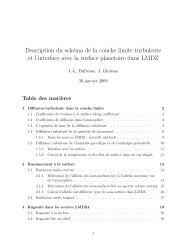Parallelism in LMDZ
Parallelism in LMDZ
Parallelism in LMDZ
- No tags were found...
Create successful ePaper yourself
Turn your PDF publications into a flip-book with our unique Google optimized e-Paper software.
MPI and OpenMP parallelismMPI : Distributed Memory parallelism●The code to be executed is replicated on all CPUs <strong>in</strong> as many processes.●Each process runs <strong>in</strong>dependently and does not have access to the otherprecesses' memory.●Data is shared via a message pass<strong>in</strong>g <strong>in</strong>terface library (MPICH,OpenMPI, etc.)which uses the <strong>in</strong>terconnection network of the mach<strong>in</strong>e. Efficiency then essentiallyrelies on the quality of the <strong>in</strong>terconnection network.●The number of processes to use is given at runtime: mpirun -n 8 gcm.eOpenMP : Shared memory parallelism●This parallelism is based on the pr<strong>in</strong>ciple of multithread<strong>in</strong>g. Multiple tasks (threads)run concurently with<strong>in</strong> a process.●Each task has (shared) access to the global memory of the process.●Loops are parallelized us<strong>in</strong>g directives (!OMP ... , which are <strong>in</strong>cluded <strong>in</strong> the soucecode where they appear as comments) <strong>in</strong>terpreted by the compiler.●The number of OpenMP threads to used is set via an environment variableOMP_NUM_THREADS (e.g.: OMP_NUM_THREADS=4)3
<strong>Parallelism</strong> <strong>in</strong> the physics●The physics handles physicalphenomena which <strong>in</strong>teract with<strong>in</strong> as<strong>in</strong>gle atmospheric column:radiation, convection boundary layer,etc.●Individual columns of atmosphere donot <strong>in</strong>teract with one another.●The parallization strategy has bennto distribute the colums ofatmosphere over all cores.●The physics grid : klon_glogeographic po<strong>in</strong>ts over klev verticallevels.First node (1) => North pole,last node (klon_glo) => South pole.8
<strong>Parallelism</strong> <strong>in</strong> the physics●●●The columns from the global doma<strong>in</strong> are first distributed among the MPI processes.● The global doma<strong>in</strong> : klon_glo columns of atmosphereThe columns of each MPI doma<strong>in</strong> are assigned to the OpenMP tasks assigned to thethat process :● In each MPI doma<strong>in</strong> : klon_mpi columns : Σ klon_mpi = klon_glo● In each OpenMP doma<strong>in</strong> : klon_omp columns : Σ klon_omp = klon_mpiIn practice, the size of the local doma<strong>in</strong> klon is an alias of klon_omp (so as to behaveexactly as when runn<strong>in</strong>g the serial code).➔ Never forget that klon varies from one core to another.9
Some code parameters l<strong>in</strong>ked to parallelismGlobal grid : module mod_grid_phy_lmdz●●●●klon_glo : number of horizontal nodes of the global doma<strong>in</strong> (1D grid)nbp_lon : number of longitude nodes (2D grid) = iimnbp_lat : number of latitude nodes (2D grid) = jjm+1nbp_lev : number of vertical levels = klev or llmMPI grid : module mod_phys_lmdz_mpi_data●●●●●●●●●●●●●klon_mpi : number of nodes <strong>in</strong> the MPI local doma<strong>in</strong>.klon_mpi_beg<strong>in</strong> :start <strong>in</strong>dex of the doma<strong>in</strong> on the 1D global grid.klon_mpi_end : end <strong>in</strong>dex of the end of the doma<strong>in</strong> on the 1D global grid.ii_beg<strong>in</strong> : longitude <strong>in</strong>dex of the beg<strong>in</strong>n<strong>in</strong>g of the doma<strong>in</strong> (2D global grid).ii_end : longitude <strong>in</strong>dex of the end of the doma<strong>in</strong> (2D global grid).jj_beg<strong>in</strong> : latitude <strong>in</strong>dex of the beg<strong>in</strong>n<strong>in</strong>g of the doma<strong>in</strong> (2D global grid).jj_end : latitude <strong>in</strong>dex of the end of the doma<strong>in</strong> (2D global grid).jj_nb : number of latitude bands = jj_end-jj_beg<strong>in</strong>+1is_north_pole : .true. If the process <strong>in</strong>cludes the North pole.is_south_pole : .true. If the process <strong>in</strong>cludes the south pole.is_mpi_root : .true. If the process is the MPI master.mpi_rank : rank of the MPI process.mpi_size : total number of MPI processes.10
Some code parameters l<strong>in</strong>ked to parallelismOpenMP grid : module mod_phys_lmdz_mpi_data●●●●●●klon_omp : number of nodes <strong>in</strong> the local OpenMP doma<strong>in</strong>.klon_omp_beg<strong>in</strong>: beg<strong>in</strong>n<strong>in</strong>g <strong>in</strong>dex of the OpenMP doma<strong>in</strong> with<strong>in</strong> the MPI doma<strong>in</strong>.klon_omp_end : end <strong>in</strong>dex of the OpenMP doma<strong>in</strong>.is_omp_root : .true. If the task is the OpenMP master thread.omp_size : number of OpenMP threads <strong>in</strong> thhe MPI process.omp_rank : rank of the OpenMP thread.11
Cod<strong>in</strong>g constra<strong>in</strong>ts <strong>in</strong> the physics●Noth<strong>in</strong>g specific to worry about change (compared to serial case) if :- There is no <strong>in</strong>teraction between atmospheric columns- No global or zonal averages need be computed- There are no <strong>in</strong>put or output files to read or write●One mandatory th<strong>in</strong>g to enforce for OpenMP : all variables declared asSAVE or <strong>in</strong> « common » blocks must be protected by an !$OMPTHREADPRIVATE clause, for <strong>in</strong>stance :REAL, SAVE :: save_var!$OMP THREADPRIVATE(save_var)●Arrays must be allocated with the local size klon, s<strong>in</strong>ce klon may vary from acore to another; for <strong>in</strong>stance :ALLOCATE (myvar(klon))Warn<strong>in</strong>g! Note that <strong>in</strong> the general case, myvar(1) or myvar(klon) are neithernorth nor south poles.●Use the logical variables, is_north_pole et is_south_pole if a specifictreatment for the poles is required12
Data transfer <strong>in</strong> the physics●Care is required if :- there is some <strong>in</strong>teraction between atmospheric columns- some zonal or global averages need be computed- files must be read or written=> Then, some transfers between MPI processes and OpenMP tasks will berequired:●All transfer rout<strong>in</strong>es are encapsulated and transparently handlecommunications between MPI processes and OpenMP tasks.●All are <strong>in</strong>clude <strong>in</strong> module : mod_phys_lmdz_transfert_paraThe transfer <strong>in</strong>terfaces handle data of all the basic types :REALINTEGERLOGICALCHARACTER : only for broadcastThe transfer <strong>in</strong>terfaces moreover can handle fields of 1 to 4 dimensions.13
Data transfer <strong>in</strong> the physics (cont<strong>in</strong>ued)Broadcast : the master process duplicates its data to all processes and tasks.Independently of the variable's dimensionsCALL bcast(var)Scatter : the master task has a field on the global grid (klon_glo) which is to be scattered tothe local grids (klon).The first dimension of the global field must be klon_glo, and the one of the local fieldmust be klonCALL scatter(field_glo,field_loc)Gather : a field def<strong>in</strong>ed on the local grids (klon) is gathered on the global grid of the masterprocess (klon_glo).The first dimension of the global field must be klon_glo, and the one of the local fieldmust be klonCALL gather(field_loc,field_glo)Scatter2D : same as Scatter exept that the global field is def<strong>in</strong>ed on a 2D grid of : nbp_lon xnbp_lat.The first and second dimensions of the global field must be (nbp_lon,nbp_lat), and thefirst dimension of the local field must be klonCALL scatter2D(field2D_glo,field1D_loc)Gather2D : gather data on the 2D grid of the master process.CALL gather2D(Field1D_loc,Field2D_glo)14
Some examplesRead<strong>in</strong>g physics parameters from files physiq.def and config.def➢ Done <strong>in</strong> conf_phys.F90➢ The master task read the value ( call get<strong>in</strong>('VEGET',ok_veget_omp)with<strong>in</strong> an !$OMP MASTER clause) and then duplicates it to the other tasks(after the !$OMP END MASTER , there is an ok_veget = ok_veget_omp )Read<strong>in</strong>g the <strong>in</strong>itial state for the physics : startphy.nc➢ Done <strong>in</strong> phyetat0.F➢ The master task of the master process (if(is_mpi_root.and.is_omp_root))reads the field on the global grid and then scatters it to the local grids us<strong>in</strong>gthe scatter rout<strong>in</strong>e.➢ Encapsulated <strong>in</strong> the get_field rout<strong>in</strong>e of the iostart module.Writ<strong>in</strong>g the f<strong>in</strong>al state for the physics : restartphy.nc➢ Done <strong>in</strong> phyredem.F➢ Encapsulated <strong>in</strong> rout<strong>in</strong>e put_field of the iostart module, put_field firstdoes a gather to collect all the local fields <strong>in</strong>to a global field. Then the mastertask of the master process writes the field <strong>in</strong> the restart file restarphy.nc.15
Illustrative example of load data from a file, (simplified) extract fromphylmd/read_map2D.F90USE dimphyUSE netcdfUSE mod_grid_phy_lmdzUSE mod_phys_lmdz_para...REAL, DIMENSION(nbp_lon,nbp_lat) :: var_glo2DREAL, DIMENSION(klon_glo) :: var_glo1DREAL, DIMENSION(klon):: varout! Read variable from file. Done by master process MPI and master thread OpenMPIF (is_mpi_root .AND. is_omp_root) THENNF90_OPEN(filename, NF90_NOWRITE, nid)NF90_INQ_VARID(nid, varname, nvarid)start=(/1,1,timestep/)count=(/nbp_lon,nbp_lat,1/)NF90_GET_VAR(nid, nvarid, var_glo2D,start,count)NF90_CLOSE(nid)! Transform the global field from 2D to 1DCALL grid2Dto1D_glo(var_glo2D,var_glo1D)ENDIF! Scatter global 1D variable to all processesCALL scatter(var_glo1D, varout)16
Writ<strong>in</strong>g output IOIPSL files and rebuild<strong>in</strong>g the results➢ Each MPI process writes data for its doma<strong>in</strong> <strong>in</strong> a dist<strong>in</strong>ct file. One thusobta<strong>in</strong>s as many files histmth_00XX.nc files as processes were used for thesimulation.➢ The doma<strong>in</strong> concerned by a given IOIPSL file is def<strong>in</strong>ed with a call tohistbeg, which is encapsulated <strong>in</strong> histbeg_phy (module iophy.F).➢ Data is gathered on the master (rank 0) OpenMP task for each process.Each MPI process then calls the IOIPSL rout<strong>in</strong>e histwrite, which isencapsulated <strong>in</strong> histwrite_phy (module iophy.F).➢ Warn<strong>in</strong>g: what is mentioned above is only true for outputs <strong>in</strong> the physics;it is also possible to make some outputs <strong>in</strong> the dynamics (triggered viaok_dyn_<strong>in</strong>s and ok_dyn_ave <strong>in</strong> run.def), but for these, data is moreovergathered on the master process so that there is only one file on output (whichis a major bottleneck, performance-wise) => should only be used fordebugg<strong>in</strong>g.17
Writ<strong>in</strong>g output IOIPSL files and rebuild<strong>in</strong>g the resultsOnce the simulation f<strong>in</strong>ished, one must gather the data <strong>in</strong> a s<strong>in</strong>gle file.This requires us<strong>in</strong>g the rebuild utility:rebuild -o histmth.nc histmth_00*.nc➢ rebuild is a utility distributed with IOIPSLSee « How to <strong>in</strong>stall IOIPSL and the rebuild utility» <strong>in</strong> the <strong>LMDZ</strong> website FAQ(http://lmdz.lmd.jussieu.fr/utilisateurs/faq-en)➢ In the IDRIS and CCRT supercomput<strong>in</strong>g centres, rebuild is available to all,along with other common tools :IDRISUlam /home/rech/psl/rpsl035/b<strong>in</strong>/rebuildAda /smphome/rech/psl/rpsl035/b<strong>in</strong>/rebuildCCRTTitaneMercureCurie/home/cont003/p86ipsl/X64/b<strong>in</strong>/rebuild/home/cont003/p86ipsl/SX8/b<strong>in</strong>/rebuild/home/cont003/p86ipsl/X64/b<strong>in</strong>/rebuild18
Mixed bag of thoughts, advice and comments➢ To run on a « local » mach<strong>in</strong>e (typically a multicore laptop):➔ An MPI library must be <strong>in</strong>stalled, and the « arch » files must becorrespond<strong>in</strong>gly modified to compile the model: 'makelmdz_fcm -archlocal ...'➔ It is always best to be able to use as much memory as possible:ulimit -s unlimited➔ It is also important to reserve enough private memory for OpenMP tasks:export OMP_STACKSIZE=200M➔ Use 'mpiexec -np n ...' to run with n processes,and 'export OMP_NUM_THREADS=m' to use m OpenMP tasks➔ Some examples and advice are given here (<strong>in</strong> English):http://lmdz.lmd.jussieu.fr/utilisateurs/guides/lmdz-parallele-sur-pc-l<strong>in</strong>ux-en➢ To run on clusters (Climserv, Ciclad, Gnome, ...) and mach<strong>in</strong>es ofsupercomput<strong>in</strong>g centres (IDRIS, CCRT,..):➔ Check the centre's documentation to see how to specify the number ofMPI processes, OpenMP tasks, local limitations (memory, run time) forbatch submission of jobs, etc.➔ Some <strong>in</strong>formation on appropriate job headers for some of the mach<strong>in</strong>eswidely used at IPSL is gathered here (<strong>in</strong> French!):https://forge.ipsl.jussieu.fr/igcmg/wiki/IntegrationOpenMP19
Illustrative Example of a purely MPI job (loadleveler) on Ada (IDRIS)> cat Job_MPI# ####################### ## ADA IDRIS ### ####################### @ job_name = test# @ job_type = parallel# @ output = $(job_name).$(jobid)# @ error = $(job_name).$(jobid)# Number of MPI processes to use# @ total_tasks = 32# Maximum (wall clock) run time hh:mm:ss# @ wall_clock_limit = 0:30:00# Default maximum memory per process is 3.5Gb, but one# can ask for up to 7.0Gb with less than 64 processes# @ as_limit = 3.5gb# End of job header# @ queuepoe ./gcm.e > gcm.out 2>&1> llsubmit Job_MPI20
Illustrative Example of a mixed MPI/OpenMP job (loadleveler) on Ada> cat Job_MPI_OMP# ####################### ## ADA IDRIS ### ####################### @ job_name = test# @ job_type = parallel# @ output = $(job_name).$(jobid)# @ error = $(job_name).$(jobid)# Number of MPI processes to use# @ total_tasks = 16# Number of OpenMP threads per MPI process# @ parallel_threads = 4# Maximum (wall clock) run time hh:mm:ss# @ wall_clock_limit = 0:30:00# Maximum memory per process is 3.5Gb x parallel_threads if more# than 64 processes; 7.0Gb x parallel_threads otherwise# @ as_limit = 14.0gb# End of job header# @ queue# Set the private stack memory for each threadexport OMP_STACKSIZE=200Mpoe ./gcm.e > gcm.out 2>&1> llsubmit Job_MPI_OMP21
libIGCM●The modipsl/libIGCM environment manages IPSL models (<strong>LMDZ</strong>OR,<strong>LMDZ</strong>ORINCA, IPSLCM5, <strong>LMDZ</strong>REPR, ORCHIDEE_OL) as a platform whichsimplifies extraction, <strong>in</strong>stallation and sett<strong>in</strong>g up simulations on thesupercomputers “traditionally” used at IPSL.●The distributed job headers and a few parameters still need be modified (e.g.memory requirements and maximum allowed run time).●Recomb<strong>in</strong>ation of the output files is automatically done.●There are regularly modipsl/libIGCM courses (organized by Josef<strong>in</strong>e Ghattas& Anne Cozic) ; sometimes <strong>in</strong> French and sometimes <strong>in</strong> English. The next isplanned to be held <strong>in</strong> February-March 2013.22
To summarize► In the physics, as long as there is no communication between columns, you candevelop and modify code “as if <strong>in</strong> serial”. Only mandatory requirement (for OpenMP):variables which have a SAVE attribute have to be declared as !$OMPTHREADPRIVATE.➔ Do take the time to check the correct <strong>in</strong>tegration of modifications! Results shouldbe identical (bitwise) when the number of processes or OpenMP threads ischanged (at least when compil<strong>in</strong>g <strong>in</strong> 'debug' mode).► In the dynamics, parallelism is much more <strong>in</strong>tr<strong>in</strong>sic; one should really take the timeto understand the whole system before modify<strong>in</strong>g any l<strong>in</strong>e of code.► One can compile <strong>in</strong> any of the follow<strong>in</strong>g parallel modes: mpi, omp or mpi_ompmakelmdz_fcm -parallel mpi ..... , makelmdz_fcm -parallel mpi_omp .....► A run should use as many cores as possible, without forgett<strong>in</strong>g that the maximumnumber of MPI processes = number of nodes along the latitude / 3 and that it isusually best to use 1 OpenMP task for every 4 or 5 po<strong>in</strong>ts along the vertical.► To optimize the workload among different MPI processes, run a first month withadjust=y <strong>in</strong> run.def. And then use the obta<strong>in</strong>ed bands_resol_Xprc.dat files for thefollow<strong>in</strong>g simulations.► Rebuild the output files once the run is over : rebuild -o histmth.nc histmth_00*.nc23







